Colijnsplaat is located on the north side of North Beveland, at the foot of the famous Zeeland Bridge. A Celtic settlement was situated near Colijnsplaat, where the Frisiavoni lived. A temple to the goddess Nehalennia existed here. Nehalennia was a goddess from Roman times who provided protection to seafarers and other travellers. Indeed in 1970 some Nehalennia altars were fished out of the Oosterscheldewere near Colijnsplaat. The current Colijnsplaat was founded in 1598 on the embankment of the Old North Beveland Polder. A harbour was built for the transportation of grain to North Beveland Schouwen-Duiveland, and for a ferry to Zierikzee. The church hall was built in 1769. After the commissioning of the six-kilometre Zeeland Bridge in 1960, the accessibility of the village improved significantly.
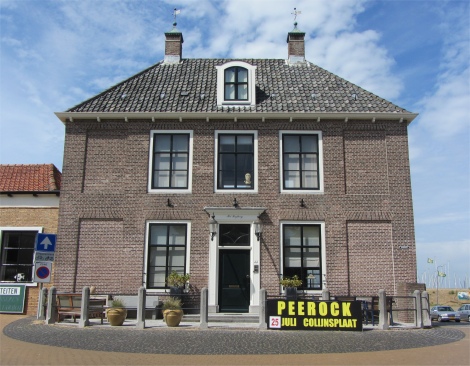
Former Town Hall
|
Five minutes walk brought us to the village which was typical of many in the area: neat two-storey houses with brick facades and a pretty tree-lined main street, Voorstraat. Nearly all the streets in the village ran parallel to the broad main street.
On the northern end of Voorstraat stood a striking mansion, the former town hall and one of the oldest buildings in Colijnsplaat. A huddle of bars and restaurants were clustered around it.
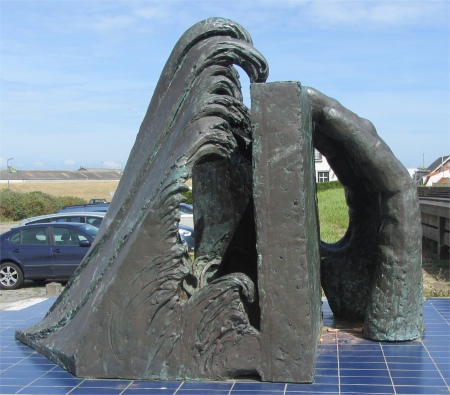
Houen Boys Monument
|
Near this building stood a monument dating from 1993 called "Houen Boys" commemorating the 1953 flood, sculpted by Jan Haas, and unveiled by living saviours of the event. Executed in bronze it depicts "the incoming wave, the flood shelves and a man's hand", and symbolises the struggle of man with the water.
On the nights January 31st to February 1st, 1953, the Netherlands was struck by the Flood Disaster. Colijnsplaat was saved by a miracle. The old port was fully operational and was connected to the Eastern Scheldt. During the night the water rose so high that it was decided to place the flood boards in their slot next to the former town hall. The water continued to rise. The waves beat against the flood defences. The centre buttress could not take the pressure of the water and began to show cracks and to "stagger". Several villagers came to the rescue and pushed against the boards and buttresses. Every time a big wave came rolling in from the port, they braced themselves to cushion the impact of the wave against the boards with their bodies. The water continued to rise to about 10 cm below the highest flood shelf. After a few hours, when most of the men were exhausted and their courage was waning, they received unexpected help from the harbour. The barge
Lead, which was in port, was thrown by the sea onto the quay in front of the defence barrier, and acted as a breakwater.
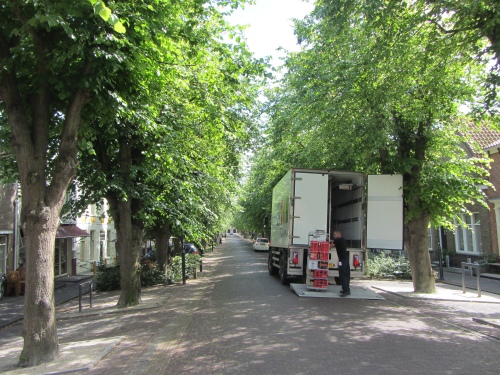
Voorstraat
|
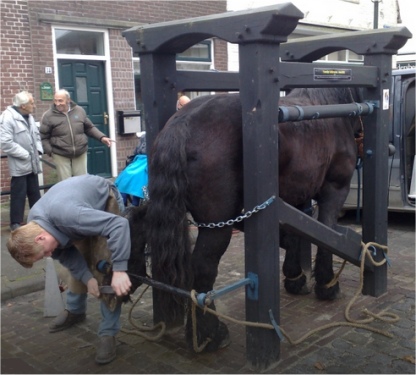
A Travalje Being Put Into Use
|
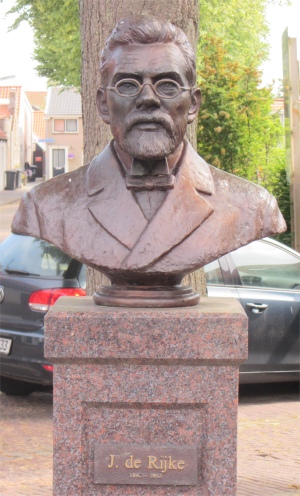
Johannes de Rijke
|
We sauntered down Voorstraat, passing a collection of cafes, small restaurants, antique and craft shops. A rather unique construction we came across was a
travalje, a device mounted in a street and used for harnessing horses inside so that they could be shod.
During our grand tour we stumbled across a statue of Johannes de Rijke. He was born in Colijnsplaat in 1842, the third of seven children of dyke worker Pieter de Rijke and his wife Anna Catharina Liefbroer. He had no money for a formal education, and was trained by the hydraulic engineer James Lebret. In 1865 he became superintendent of the construction of the Oranjesluizen. In 1872 his boss, C.J. van Doorn, went to Japan and asked De Rijke to accompany him. De Rijke became an engineer in the Japanese service. He designed two breakwaters for the port of Osaka, a high-pressure water system in Osaka and a jetty in Kobe. He improved the ports of Tokyo and Yokohama. Along with his colleague GA Escher (father of the graphic artist M.C. Escher) he planned to improve various Japanese rivers; a tunnel channel from Lake Biwa to Kyoto and the canalisation of the Kisorivier, the plans being implemented from 1887 to 1912. Thanks to the plan, the flooding of the city Nagoya now belonged to the past. From 1891 De Rijke worked for the Japanese Ministry of Transport. In 1903 he returned to the Netherlands. He died at the age of 70 in Amsterdam and is buried in the Amsterdam cemetery Zorgvlied. His grave is visited annually by a Japanese delegation that lay a wreath during a Buddhist ceremony. A statue of De Rijke stands in the city of Nagoya.
A quick shimmy at the bottom of this street brought us into streets full of "barns". At one time the village was full of farmers' sheds and barns, and many of these had been converted into residential and commercial premises. The timbers were almost always black, many coated in what seemed to be centuries old pitch. I stared at one rather impressive one that had caught my attention, when a lady wheeled out her bicycle. I guessed she was of a similar age to us. "How old is the building?" I asked. She gave me a warm smile, "This building belonged to my father, who was a farmer. It was in a bad way, and it was cheaper to demolish the original building and build a new wooden one," she explained. She now lived in this new building. "But in winter, when the wind gets up, these buildings are bitterly cold," she added.
Many similar buildings in the street had old ploughs and the likes in small patches of ground in front of the buildings. The village had been very agricultural in the past.
As we wandered we came across many beautifully kept gardens, manicured to within an inch of their lives. Even the sports centre was immaculate. Folk zoomed past us on cycles, no bells were sounded, just the occasional shout in Dutch.

Examples of Barns
|
In the evening we dined in one of the restaurants near the old town hall. Sad to report one of Rex's fillings fell out during his meal, and over the next hour or so we discovered which town nearby contained a dentist, who the dentist was and the opening time, and a taxi service that could provide transport there. An eventful evening. Poor Rex felt the need to absorb copious amounts of beer to deaden his senses, or so he said. The staff in the restaurant were kind and helpful, and we thanked them profusely.
We returned to the boat under a cloudless sky, with very little wind. It was eerily silent, none of the geese and bird chatter that we had encountered at the Roompot marina. The occasional plane cruised high overhead, its existence betrayed by its distinct roars.
Rex checked weather forecasts over the internet; heat waves all round were predicted. Hmm.... famous last words perhaps?







